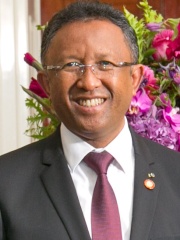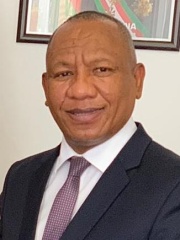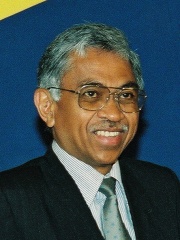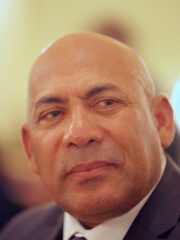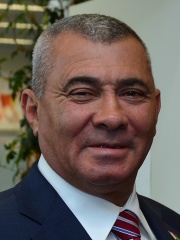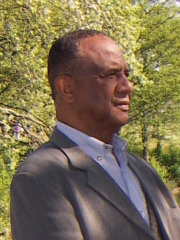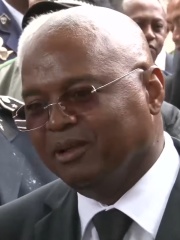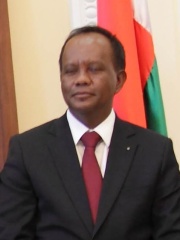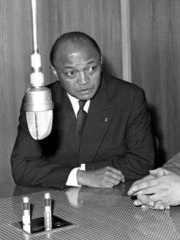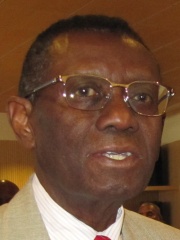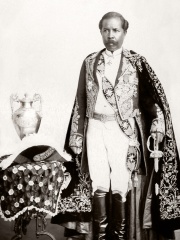
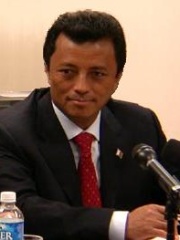
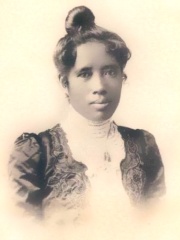
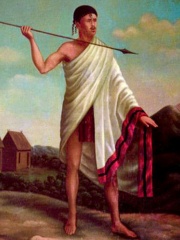
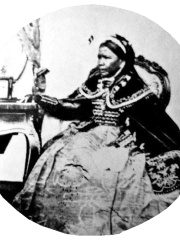
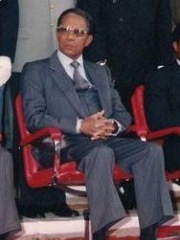
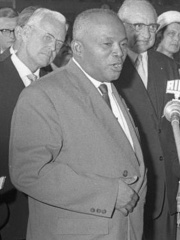
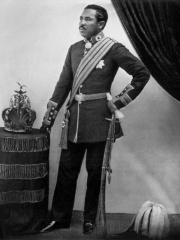
The Most Famous
POLITICIANS from Madagascar
This page contains a list of the greatest Malagasy Politicians. The pantheon dataset contains 19,576 Politicians, 31 of which were born in Madagascar. This makes Madagascar the birth place of the 90th most number of Politicians behind Malaysia, and Armenia.
Top 10
The following people are considered by Pantheon to be the top 10 most legendary Malagasy Politicians of all time. This list of famous Malagasy Politicians is sorted by HPI (Historical Popularity Index), a metric that aggregates information on a biography's online popularity. Visit the rankings page to view the entire list of Malagasy Politicians.

1. Ranavalona I (1788 - 1861)
With an HPI of 70.33, Ranavalona I is the most famous Malagasy Politician. Her biography has been translated into 34 different languages on wikipedia.
Ranavalona I (born Rabodonandrianampoinimerina; 1778–16 August 1861), also known as Ramavo or Ranavalo-Manjaka I or Ranavalona reniny, was the sovereign of the Kingdom of Madagascar from 1828 to 1861. After positioning herself as queen following the death of her young husband Radama I, she pursued a policy of isolationism and self-sufficiency. She sought reduced economic and political ties with European powers and took vigorous measures to eradicate the small but growing Malagasy Christian movement initiated under Radama I by members of the London Missionary Society. Ranavalona made heavy use of the traditional practice of fanompoana (forced labor as tax payment) to complete public works projects and develop an army. She had a standing army of between 20,000 and 30,000 Merina soldiers, whom she deployed to pacify outlying regions of the island and further expand the realm. The combination of regular warfare, slavery, disease, difficult forced labor and the practice of tangena (a harsh trial by ordeal using a poisonous nut from the Cerbera manghas tree) resulted in a high mortality rate among both soldiers and civilians during her 33-year reign, reducing Madagascar's population from 5 million in 1833 to 2.5 million in 1839. Although greatly obstructed by Ranavalona's policies, foreign political interests in Madagascar remained undiminished. Divisions between traditionalist and pro-European factions at the queen's court created opportunities that European intermediaries leveraged in an attempt to hasten the succession of her son Radama II. The young prince disagreed with many of his mother's policies and was amenable to French proposals for the exploitation of the island's resources, as expressed in the Lambert Charter he concluded with a French representative in 1855. However, these plans were not successful and Radama II did not take the throne until Ranavalona's death in 1861 at the age of 83. Ranavalona's European contemporaries generally condemned her policies and characterized her as a tyrant at best and insane at worst. These negative characterizations, earning her the moniker of the "Mad Monarch of Madagascar", persisted in Western scholarly literature until the mid-1970s. Later academic research recast Ranavalona's actions as those of a queen attempting to expand her empire while protecting Malagasy sovereignty against the encroachment of European cultural and political influence.

2. Marc Ravalomanana (b. 1949)
With an HPI of 67.55, Marc Ravalomanana is the 2nd most famous Malagasy Politician. His biography has been translated into 47 different languages.
Marc Ravalomanana (Malagasy: [raˌvaluˈmananə̥]; born 12 December 1949) is a Malagasy politician who served as the sixth president of Madagascar from 2002 to 2009. Born into a farming Merina family in Imerinkasinina, near the capital city of Antananarivo, Ravalomanana first rose to prominence as the founder and CEO of the vast dairy conglomerate TIKO, later launching successful wholesaler MAGRO and several additional companies. He entered politics in 1999 by founding the Tiako Iarivo party and successfully ran for the position of mayor of Antananarivo, serving from 1999 to 2001. During his tenure, he improved sanitary and security conditions in the city. In August 2001, he announced his candidacy as an independent in the upcoming presidential election. He then took office as president in 2002 amidst a dispute over election results in which he successfully pressed his claim to have won a majority in the first round. Under the leadership of Jacques Sylla, Ravalomanana's prime minister from 2002 to 2007, the political party Tiako I Madagasikara (TIM) was founded in 2002 to support Ravalomanana's presidency and came to dominate legislative and local elections. Ravalomanana was re-elected in December 2006, again with a majority in the first round. During Ravalomanana's presidency, Madagascar made significant advances toward development targets and experienced an average of seven per cent growth per year. His administration oversaw the construction of thousands of new schools and health clinics. Road rehabilitation aided in improving rural farmers' access to markets. The establishment of the independent anti-corruption agency BIANCO, and the adoption of diverse supporting policies resulted in a decline in governmental corruption. Opposition members criticized Ravalomanana in the later period of his presidency, accusing him of increasing authoritarianism and the mixing of public and private interests. In addition, the benefits of the country's growth were not evenly spread, leading to increased wealth inequality, inflation and a decline in purchasing power for the lower and middle classes. In 2008 a controversial land lease agreement with Korean agricultural firm Daewoo, the purchase of a costly presidential jet and the closure of media channels owned by opposition leader and mayor of Antananarivo, Andry Rajoelina, strengthened popular disapproval of his policies. Rajoelina rallied popular support for the opposition, leading to a popular uprising that began in January 2009 and ended two months later with Ravalomanana's resignation under pressure and Rajoelina taking control with military support in a power transfer viewed by the international community as a coup d'état. From 2009 to 2012 Ravalomanana lived in exile in South Africa, where he was engaged in active negotiations with Rajoelina and former heads of state Albert Zafy and Didier Ratsiraka to organize national elections. In December 2012 he declared he would not present himself as a candidate, then a precondition to the elections being viewed as legitimate by the international community. TGV candidate Hery Rajaonarimampianina was elected president in January 2014, defeating Jean-Louis Robinson, the candidate of Marc Ravalomanana's camp. Upon attempting to return to Madagascar in October 2014 he was arrested, having been sentenced in absentia to lifelong hard labour for abuses of power by the Rajoelina administration. After his sentence was lifted and he was freed from house arrest in May 2015, Ravalomanana announced the re-opening of the Tiko business group and was re-elected the president of TIM.

3. Ranavalona III (1861 - 1917)
With an HPI of 67.40, Ranavalona III is the 3rd most famous Malagasy Politician. Her biography has been translated into 40 different languages.
Ranavalona III (Malagasy pronunciation: [ranaˈvalːə̥]; 22 November 1861 – 23 May 1917) was the last sovereign of the Kingdom of Madagascar. She ruled from 30 July 1883 to 28 February 1897 in a reign marked by ultimately futile efforts to resist the colonial designs of the government of France. As a young woman, she was selected from among several Andriana qualified to succeed Queen Ranavalona II upon her death. Like both preceding queens, Ranavalona entered a political marriage with a member of the Hova elite named Rainilaiarivony, who largely oversaw the day-to-day governance of the kingdom and managed its foreign affairs in his role as prime minister. Ranavalona tried to stave off colonization by strengthening trade and diplomatic relations with foreign powers throughout her reign, but French attacks on coastal port towns and an assault on the capital city of Antananarivo led to the capture of the royal palace in 1895, ending the sovereignty and political autonomy of the centuries-old kingdom. Ranavalona and her court were initially permitted to remain as symbolic figureheads, but the outbreak of a popular resistance movement called the menalamba rebellion, and the discovery of anti-French political intrigues at court, led the French to exile her to the island of Réunion in 1897. Rainilaiarivony died that same year, and Ranavalona was relocated to a villa in Algiers, along with several members of her family. The queen, her family, and the servants accompanying her were provided an allowance and enjoyed a comfortable standard of living, including occasional trips to Paris for shopping and sightseeing. Ranavalona was never permitted to return home to Madagascar, however, despite her repeated requests. She died of an embolism at her villa in Algiers in 1917 at age 55. Her remains were buried in Algiers but were disinterred 21 years later and shipped to Madagascar, where they were placed within the tomb of Queen Rasoherina on the grounds of the Rova of Antananarivo.

4. Andrianampoinimerina (1745 - 1810)
With an HPI of 66.27, Andrianampoinimerina is the 4th most famous Malagasy Politician. His biography has been translated into 31 different languages.
Andrianampoinimerina (Malagasy pronunciation: [anˈɖʐianˌmpuʲnˈmerʲnə̥]) (c. 1745–1810) ruled the Kingdom of Imerina on Madagascar from 1787 until his death. His reign was marked by the reunification of Imerina following 77 years of civil war, and the subsequent expansion of his kingdom into neighboring territories, thereby initiating the unification of Madagascar under Merina rule. Andrianampoinimerina is a cultural hero and holds near mythic status among the Merina people, and is considered one of the greatest military and political leaders in the history of Madagascar. Andrianampoinimerina (whose name means "the king in the heart of Imerina") took power upon deposing his uncle, King Andrianjafy, who had ruled over Imerina Avaradrano (Northern Imerina). Prior to Andrianampoinimerina's reign, Imerina Avaradrano had been locked in conflict with the three other neighboring provinces of the former kingdom of Imerina that had last been unified under King Andriamasinavalona a century before. Andrianampoinimerina established his capital at the fortified town of Ambohimanga, a site of great spiritual, cultural and political significance that was designated a UNESCO World Heritage Site in 2001. The king's original royal lodgings can still be visited at Ambohimanga today. From this position, he progressively extended his domain first over all Imerina and then over the greater Highlands, absorbing the Betsileo, Sihanaka, Bezanozano and Bara territories. Having reigned for 23 years at the time of his death, Andrianampoinimerina had successfully reunited Imerina and vastly expanded the Merina kingdom, with the intent to ultimately unify all of Madagascar under Merina rule. His son and heir, Radama I, continued the conquests Andrianampoinimerina had begun, and over the next two decades largely achieved his father's vision.

5. Radama I (1793 - 1828)
With an HPI of 66.12, Radama I is the 5th most famous Malagasy Politician. His biography has been translated into 29 different languages.
Radama I "the Great" (c. 1793–1828) was the first Malagasy sovereign to be recognized as King of Madagascar (1810–1828) by a European state, Great Britain. He came to power at the age of 17 following the death of his father, King Andrianampoinimerina. Under Radama's rule and at his invitation, the first Europeans entered his central highland Kingdom of Imerina and its capital at Antananarivo. Radama encouraged these London Missionary Society envoys to establish schools to teach tradecraft and literacy to nobles and potential military and civil service recruits. They also introduced Christianity and taught literacy using the translated Bible. A wide range of political and social reforms were enacted under Radama's rule, including an end to the international slave trade, although this had historically been a key source of wealth and armaments for the Merina monarchy. Through aggressive military campaigns he successfully united two-thirds of the island under his rule. Abuse of alcohol weakened his health and he died prematurely at age 35. He was succeeded by his highest-ranking wife, Ranavalona I.

6. Ranavalona II (1829 - 1883)
With an HPI of 65.23, Ranavalona II is the 6th most famous Malagasy Politician. Her biography has been translated into 30 different languages.
Ranavalona II (1829 – 13 July 1883) was Queen of Madagascar from 1868 to 1883, succeeding Queen Rasoherina, her first cousin. She is best remembered for Christianizing the royal court during her reign.

7. Didier Ratsiraka (1936 - 2021)
With an HPI of 65.12, Didier Ratsiraka is the 7th most famous Malagasy Politician. His biography has been translated into 37 different languages.
Didier Ignace Ratsiraka (Malagasy: [raˈtsirəkə̥]; 4 November 1936 – 28 March 2021) was a Malagasy politician and naval officer who was the third president of Madagascar from 1975 to 1993 and the fifth from 1997 to 2002. At the time of his death, he was the longest-serving president of Madagascar. He was first appointed president in 1975 by the military leadership, he was then reelected twice in 1982 and 1989. While he lost to Albert Zafy in 1992, Ratsiraka returned to office after winning the 1997 election. After the 2001 election, he and his opponent Marc Ravalomanana engaged in a lengthy standoff after the latter refused to participate in a runoff election; Ratsiraka eventually stepped down.

8. Philibert Tsiranana (1912 - 1978)
With an HPI of 65.07, Philibert Tsiranana is the 8th most famous Malagasy Politician. His biography has been translated into 38 different languages.
Philibert Tsiranana (18 October 1912 – 16 April 1978) was a Malagasy politician who served as the seventh prime minister of Madagascar from 1958 to 1959, and subsequently as the country's first president from 1959 to 1972. During the twelve years of his administration, the Republic of Madagascar experienced institutional stability that stood in contrast to the political turmoil many mainland African countries experienced in this period. This stability contributed to Tsiranana's popularity and his reputation as a remarkable statesman. Madagascar experienced moderate economic growth under his social democratic policies and came to be known as "the Happy Island." However, the electoral process was fraught with issues and his term ultimately terminated in a series of farmer and student protests that brought about the end of the First Republic and the establishment of the officially socialist Second Republic. The "benevolent schoolmaster" public image that Tsiranana cultivated went alongside a firmness of convictions and actions that some believe tended toward authoritarianism. Nonetheless, he remains an esteemed Malagasy political figure remembered throughout the country as its "Father of Independence".

9. Radama II (1829 - 1863)
With an HPI of 63.98, Radama II is the 9th most famous Malagasy Politician. His biography has been translated into 27 different languages.
Radama II (September 23, 1829 – May 12, 1863 [contested]) was the son and heir of Queen Ranavalona I and ruled from 1861 to 1863 over the Kingdom of Madagascar, which controlled virtually the entire island. Radama's rule, although brief, was a pivotal period in the history of the Kingdom of Madagascar. Under the unyielding and often harsh 33-year rule of his mother, Queen Ranavalona I, Madagascar had successfully preserved its cultural and political independence from European colonial designs. Rejecting the queen's policy of isolationism and persecution of Christians, Radama II permitted religious freedom and re-opened Madagascar to European influence. Under the terms of the Lambert Charter, which Radama secretly contracted in 1855 with French entrepreneur Joseph-François Lambert while Ranavalona still ruled, the French were awarded exclusive rights to the exploitation of large tracts of valuable land and other lucrative resources and projects. This agreement, which was later revoked by Prime Minister Rainilaiarivony, was key to establishing France's claim over Madagascar as a protectorate and, in 1896, as a colony. The dramatic contrast between Ranavalona's isolationism and her son's pro-European stance represented an abrupt reversal of policy that threatened the traditional sociopolitical order. Radama's absolutism in pursuing dramatic reforms in disregard of the advice of his ministers ultimately turned them against him. In a coup led by his prime minister, Rainivoninahitriniony, Radama II was strangled on May 12, 1863. His wife Rabodo, who took the throne name Rasoherina, was allowed by the ministers to succeed her husband on the condition that she and future sovereigns would no longer rule unilaterally, but rather in concert with the Hova (the class of free citizens) as represented by the position of prime minister. The public was informed that Radama had committed suicide and that his body had been unceremoniously interred in a tomb in Ilafy. However, there soon emerged rumors – believed by prominent foreigners Jean Laborde and William Ellis – that Radama lived and was making plans to reclaim the throne. A strong case has since been made on the basis of significant evidence that Radama may indeed have revived after the strangling and lived to old age in anonymity near Lake Kinkony in the northwestern part of the island.
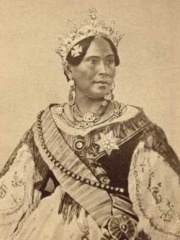
10. Rasoherina (1814 - 1868)
With an HPI of 63.86, Rasoherina is the 10th most famous Malagasy Politician. Her biography has been translated into 24 different languages.
Rasoherina (1814 – 1 April 1868) (also Rasoherina-Manjaka) was Queen of Madagascar from 1863 to 1868, succeeding her husband Radama II following his presumed assassination.
People
Pantheon has 31 people classified as Malagasy politicians born between 1745 and 1974. Of these 31, 12 (38.71%) of them are still alive today. The most famous living Malagasy politicians include Marc Ravalomanana, Hery Rajaonarimampianina, and Andry Rajoelina. The most famous deceased Malagasy politicians include Ranavalona I, Ranavalona III, and Andrianampoinimerina. As of April 2024, 1 new Malagasy politicians have been added to Pantheon including Michael Randrianirina.
Living Malagasy Politicians
Go to all RankingsMarc Ravalomanana
1949 - Present
HPI: 67.55
Hery Rajaonarimampianina
1958 - Present
HPI: 62.29
Andry Rajoelina
1974 - Present
HPI: 60.34
Christian Ntsay
1961 - Present
HPI: 58.90
Norbert Ratsirahonana
1938 - Present
HPI: 57.27
Omer Beriziky
1950 - Present
HPI: 56.67
Albert Camille Vital
1952 - Present
HPI: 54.59
Désiré Rakotoarijaona
1934 - Present
HPI: 51.21
Jean Ravelonarivo
1959 - Present
HPI: 50.34
Rivo Rakotovao
1960 - Present
HPI: 49.62
Monja Roindefo
1965 - Present
HPI: 47.26
Michael Randrianirina
1973 - Present
HPI: 16.86
Deceased Malagasy Politicians
Go to all RankingsRanavalona I
1788 - 1861
HPI: 70.33
Ranavalona III
1861 - 1917
HPI: 67.40
Andrianampoinimerina
1745 - 1810
HPI: 66.27
Radama I
1793 - 1828
HPI: 66.12
Ranavalona II
1829 - 1883
HPI: 65.23
Didier Ratsiraka
1936 - 2021
HPI: 65.12
Philibert Tsiranana
1912 - 1978
HPI: 65.07
Radama II
1829 - 1863
HPI: 63.98
Rasoherina
1814 - 1868
HPI: 63.86
Gabriel Ramanantsoa
1906 - 1978
HPI: 62.80
Albert Zafy
1927 - 2017
HPI: 62.51
Rainilaiarivony
1828 - 1896
HPI: 60.67
Newly Added Malagasy Politicians (2025)
Go to all RankingsOverlapping Lives
Which Politicians were alive at the same time? This visualization shows the lifespans of the 17 most globally memorable Politicians since 1700.

